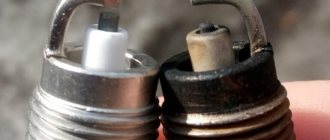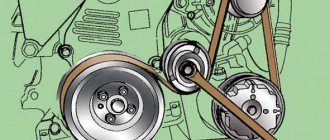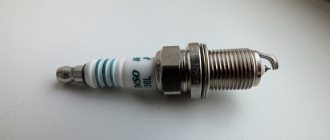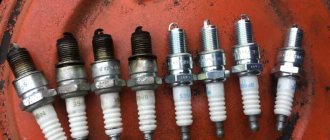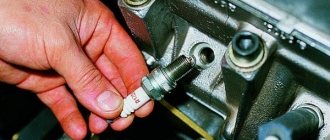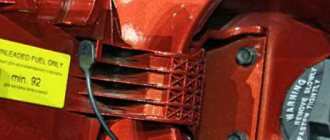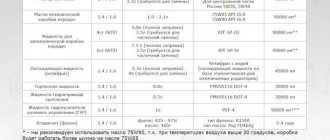In accordance with technical regulations, spark plugs on Hyundai Solaris with 1.4 and 1.6 liter engines must be replaced every 60,000 km. However, depending on the operating conditions of the car, as well as based on the condition of the spark plugs themselves, replacement can be done earlier, for example, every 30-45 thousand kilometers.
What kind of spark plugs are on the car from the factory?
On Solaris, the company used spark plugs from two manufacturers: CHAMPION and NGK. Until 2014, both brands were used. Since 2014, only spark plugs from the Japanese company NGK have been installed on restyled cars.
It must be said that for engines 1.4 and 1.6 the same spark plugs are used throughout the entire production period of the car.
Spark plugs CHAMPION and NGK
The car had regular spark plugs. You can install iridium ones, but these were not installed from the factory, although they were used on the same engines, which were not only on Solaris.
Basic parameters and installation gap between electrodes
NGK Iridium Spark Plug
Top 1. Bosch YR8SEU (0 242 129 515)
Rating (2021): 4.73 Taken into account Review of reviews from resources: 11Most popular
High quality workmanship and increased service life due to the yttrium alloy electrode, coupled with reasonable cost, have led to the serious popularity of the Bosch YR8SEU among Hyundai Solaris owners.
- Characteristics Average price: 241 rub.
- Country: Germany
- Electrode material: yttrium
- Gap, mm: 1.0
- Heat number: 8
- Resource, km: 60000
One of the best spark plugs for Hyundai Solaris cars and a number of similar models with 1.4 and 1.6 liter engines. The central electrode is made of high-quality yttrium alloy, which ensures rapid ignition and reduced fuel consumption. The anti-corrosion shell of the copper core increases the service life, so frequent replacement is not required. They work flawlessly even in difficult conditions. On many Korean models, YR8SEU spark plugs are supplied as standard; when the service life wears out, it is recommended to replace them with the same ones. A pleasant bonus is the inexpensive cost, but the popularity of the brand and affordable price have led to the appearance of a large number of fakes on the market.
Advantages and disadvantages
- German quality
- Low price
- Time-tested reliability
- Lots of fakes
Replacement timing
The instruction manual says to replace the spark plugs at 60 thousand km or after 48 months. As for the recommendation about time replacement. Such a recording is not related to actual operation. There are quite a lot of cars with mileage less than 60,000 km and a longer operating period than indicated in the manual. Candles can last longer than 48 months.
Screenshot from the instruction manual
As for the mileage replacement, the figure is greatly overestimated. You can drive 60 thousand km, there are cars that can travel even more. But do you need it? Let's figure it out.
With an increased gap, in order for a spark to form, the voltage on the ignition coils must be higher than with the nominal gap, this leads to additional load and earlier failure of the coils themselves. In terms of money, it is always more profitable to change spark plugs than to change expensive coils later.
The second point is related to the catalyst. Plugs with an increased gap will cause misfires in the cylinder the further they go. Consequently, the fuel-air mixture flies into the catalyst, where ignition from the hot cells already occurs. There is nothing useful for his resource in this.
New and old spark plug 57 thousand km
If you are still going to change spark plugs every 60 thousand km, then at least bend the side electrode to a gap of 1-1.1 mm. This needs to be done already at 30 thousand km.
Top 3. NGK 1578 (LZKR6B-10E)
Rating (2021): 4.42 28 reviews from resources taken into account: Yandex.Market, OtzovikImmaculate quality
NGK 1578 spark plugs are capable of lasting at least 50% longer than their declared lifespan, which indicates impeccable build quality and the materials used.
- Characteristics Average price: 399 rub.
- Country: Japan
- Electrode material: nickel
- Gap, mm: 1.0
- Heat number: 6
- Resource, km: 30000
This is the best spark plug for Hyundai Solaris, Elantra and other KIA models with engines of 1.4 and 1.6. It’s not without reason that drivers try to replace standard spare parts with NGK 1578 – the igniter lasts 30 thousand km without complaints, and performs even better than the original from Korea, but costs less. After replacement, the characteristic gasoline smell of exhaust gases changes noticeably due to more complete combustion of the mixture, the car “comes to life”, and fuel consumption decreases. It is better to buy it in trusted places, as fakes are common. The regulations state replacement after 60 thousand km, but in urban conditions it is better not to delay this. Thrifty taxi drivers, according to reviews, can easily drive 45 thousand km on these spark plugs.
Advantages and disadvantages
- Japanese quality
- Relatively inexpensive price
- Reliable in operation
- There are many fakes
Rating (2021): 4.31 Best price
Champion OE201T10 spark plugs will cost the owner of a Hyundai Solaris more than half the price of the original products.
- Characteristics Average price: 196 rub.
- Country: USA
- Electrode material: nickel
- Gap, mm: 0.9
- Heat number: 8
- Resource, km: 30000
These resistance flat seat spark plugs are also available as RER8MC. The nickel electrode and fairly inexpensive cost have virtually no effect on the performance of the product. They can often be found in factory equipment on the Hyundai Solaris, Elantra and a number of Kia models. According to the regulations, replacement is required every 30 thousand km, and they serve their service life properly. In reviews there are complaints about the gap, but when purchasing, you should make sure that you are dealing with an original product. Their quality is good, tested by more than one thousand users - they work well on engines with volumes of 1.4 and 1.6 liters, being the best budget option for such engines.
Advantages and disadvantages
- Cheap price
- Proper work
- Suitable for many Hyundai and KIA models
- It's easy to fall for a fake
Check and signs of wear
At a mileage of 30 thousand km you already need to check the spark plugs. Very often they are sentenced to replacement if there is a brown band on the insulator. If there is a band, it means gases are escaping from the combustion chamber and the spark plug is not airtight. THIS IS A MYTH THAT BECAME TRUE!
The belt on the insulator is not an indicator of the condition of the spark plug
If you cut off the upper part of the body, you can see that there is no such belt underneath. Therefore, this has nothing to do with the tightness of the insulator.
The belt on the insulator is not an indicator of the condition of the spark plug
Now the most important thing is why you need to unscrew the spark plugs. This is a clearance check. It should be 1-1.1 mm.
New and worn electrodes
If it is not greatly enlarged and the central electrode is not very worn, you can slightly bend the side electrode to the desired value and gain some more mileage before replacement.
Typically, a spark eats away the central electrode, and the side one turns from rectangular to rounded.
Top 2. Denso XU22HDR9
Rating (2021): 4.45 Taken into account Review of reviews from resources: 47Best value for money
Japanese Denso XU22HDR9 spark plugs provide high-quality sparking and no breakdowns throughout their entire service life, without requiring premature replacement. The product's characteristics are balanced by the cost, which many Hyundai Solaris owners consider reasonable and fair.
- Characteristics Average price: 395 rub.
- Country: Japan
- Electrode material: nickel
- Gap, mm: 0.9
- Heat number: 22
- Resource, km: 30000
Nickel spark plugs of a standard design captivate users with their inexpensive cost. At the same time, they have a number of important features. The horseshoe-shaped groove of the side electrode ensures lower fuel consumption due to reliable ignition of the mixture and its complete combustion. The copper core has a long service life - the spark plug works flawlessly for about 70 thousand km, without requiring any maintenance, much less replacement. Another advantage is self-cleaning from carbon deposits. Igniters are sold complete with a flat cover. Suitable for 1.4 and 1.6 liter petrol engines. It is reasonably considered the best option for Hyundai Solaris and other models of this manufacturer, as well as KIA cars.
Replacing spark plugs
A very simple job that probably anyone can do. Minimum tools.
Unscrew the 4 bolts of the valve cover lining
Unscrew the ignition coils
Removing the coils
Another option for removing coils
Your browser does not support the format
Now you can unscrew the spark plugs
Using a 16 mm socket or spark plug wrench, unscrew the spark plugs
When installing new spark plugs, be careful. It should screw in easily. If you immediately feel the force, then the candle has gone wrong. Unscrew it and try again. Final tightening torque 25 Nm.
How to properly tighten spark plugs without a torque wrench can be seen in the video
Your browser does not support the format
Ignition coil Hyundai Accent
The Hyundai Accent ignition coil converts low-voltage voltage, which comes from the battery, as well as the generator, into high-voltage. The Hyundai Accent has two ignition coils: for the first and fourth and second and third cylinders.
Symptoms of a problem
Malfunctions of the Hyundai ignition coil are manifested in the following:
- Misfires.
- At certain speeds there are dips.
- The coil is overheating.
- Engine performance decreases.
- The engine does not start.
- The Accent ignition coil sparks.
How to check
To check the ignition coil you will need an ohmmeter.
- We measure the resistance between the first and second contacts of connector C11-2, then connector C11-1. The resistance should be 0.5±0.05 kOhm.
- We measure the resistance of the secondary winding between terminals 1 and 4 of cylinders, then between terminals of 2 and 3 cylinders. Here the resistance of a working coil is 12.1 ± 1.8 kOhm.
Basic faults
The main failures of the coil include damage to its body or tips, insulation breakdown, overheating and short circuit. If the coil breaks, it must be replaced. You can replace the ignition coil yourself; you do not need special knowledge for this.
How to replace
If, during the process of identifying a malfunction, we determine that the coil is out of order, the following procedure must be followed:
- Turn off the ignition.
- Remove the air filter housing. This stage is optional; removal is necessary for the convenience of subsequent work.
- Press the latch and disconnect the wire harnesses from the coil of the second and third cylinders.
- Also disconnect the harnesses from the other coil (the first and fourth cylinders).
- Remove the ends of the high-voltage wires from the coils.
- Unscrew the screws securing the coils.
- Remove the coils and replace them with good ones.
Iridium spark plugs pros and cons
The main advantage of iridium spark plugs is the resource, the disadvantage is the price. In fact, iridium spark plugs are cheaper during operation.
Central and side electrodes made of more resistant materials
For some reason, there is no information anywhere that such spark plugs, compared to regular ones, greatly extend the life of ignition coils. Part of this, of course, is due to the fact that most people drive with regular spark plugs until the car shakes. After working at increased spark gaps, the coils quickly fail.
If the coils did not see regular spark plugs and immediately worked on iridium spark plugs, you will most likely not be faced with replacing the coils anytime soon.
Below are two graphs comparing conventional and iridium spark plugs during operation.
Fuel economy chart
Graph of power changes during operation
You may have encountered or heard that iridium spark plugs do not last as long as stated. Why this situation is possible is discussed below.
Causes of ignition coil failure on Hyundai Solaris
The ignition coil (IC) on a Hyundai Solaris, like on any other car, can fail. In this case, it will have to be removed for a complete replacement or for further repairs. As practice shows, most of the work related to short circuits can be done on your own. Let's look at how to do this.
general information
All configurations of Hyundai Solaris, regardless of the displacement of the power unit, are equipped with almost identical coils. This device is necessary for transforming low-voltage voltage into high-voltage on cars equipped with a gasoline engine. Also, the task of the coil is to generate a high-voltage pulse on the glow plugs.
The described device has a cylindrical body. Inside it there is a part with two windings. The windings themselves are wound onto a metal core, and the structure is filled with transformer-type oil. Quite often during operation the coil breaks. There are a number of signs that indicate this kind of problem.
Reasons for failure
The ignition coil on the Hyundai Solaris is used to start the engine. The first sign of its breakdown will be the inability to start the power unit. Problems with the coil are also indicated by failures during the operation of the internal combustion engine. The engine starts to stall. The Solaris dashboard is equipped with a specialized sensor that immediately reminds you of itself if there are interruptions in the power system.
The most common causes of short circuit failure:
- The spark plugs that were installed on the car were not of the highest quality.
- The gap on the spark plugs is incorrect.
- The candles have exhausted their resource.
- There is a breakdown in the insulator.
There are a number of points indicating that the coil is broken:
- The engine is shaking.
- When you press the accelerator pedal sharply, dips are felt.
- The corresponding indicator lights up on the dashboard.
- During cold weather, certain difficulties arise with starting the vehicle.
Checking and replacing parts
Algorithm of actions:
- Disconnect all wires from the coil, having first removed the terminals from the battery.
- Check the resistance on the primary and then on the secondary winding.
- Measure the resistance of the first and fourth cylinders. Now the problems with the coil will be confirmed or refuted. If replacement is planned, make sure that the working spark plugs are installed with the correct gap.
- Remove the fasteners and then remove the broken part.
- Supply a working spare part.
- Connect all wires.
- Check the tightness of all bolts.
see also
Comments 30
I also just changed the mileage 25800, my lighter ones are not so black
What idiot came up with the idea of counterfeiting nickel candles that cost three kopecks? Apparently, the video is about pseudo-original candles, and counterfeiting original products is always profitable - yes. Counterfeiting NGK in NGK boxes and costing 30 rubles per set is not economically feasible, IMHO.
30 thousand is the limit for these candles. The consumption does not change, nor does the thrust, but misfires and the load on the coils increase, gas breakthroughs appear on the insulator (brown marks on the ceramic part as a result of the loss of seal of the spark plug), and it is oh so difficult for a simple driver to notice this. So it’s better to change nickel spark plugs every 25 thousand and not worry, or throw in iridium spark plugs and forget about replacement for 100,000 km
Brown traces are not a breakthrough of gases, they are a coronary discharge.
In fact, yes, but with worn-out spark plugs, gas breakthrough is already possible
I agree, but it will be black as soot.
What idiot came up with the idea of counterfeiting nickel candles that cost three kopecks? Apparently, the video is about pseudo-original candles, and counterfeiting original products is always profitable - yes. Counterfeiting NGK in NGK boxes and costing 30 rubles per set is not economically feasible, IMHO.
30 thousand is the limit for these candles. The consumption does not change, nor does the thrust, but misfires and the load on the coils increase, gas breakthroughs appear on the insulator (brown marks on the ceramic part as a result of the loss of seal of the spark plug), and it is oh so difficult for a simple driver to notice this. So it’s better to change nickel spark plugs every 25 thousand and not worry, or throw in iridium spark plugs and forget about replacement for 100,000 km
